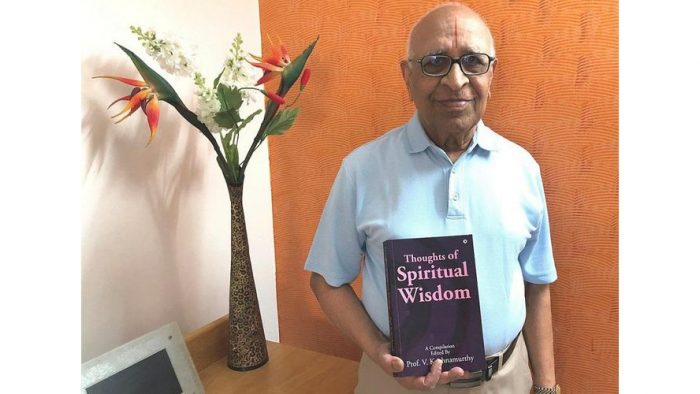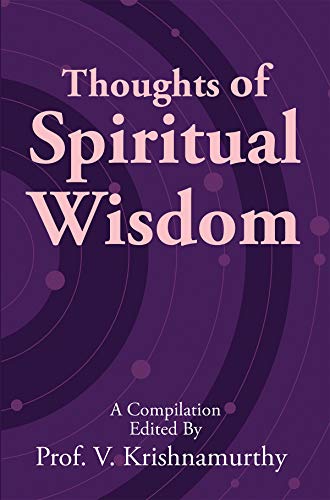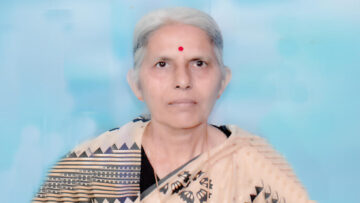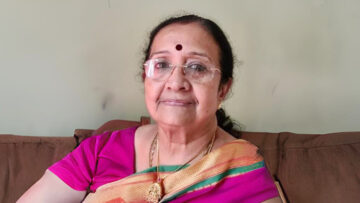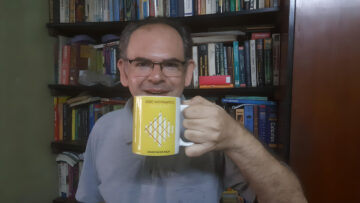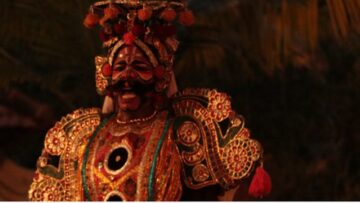There is perhaps a unique connection between Mathematics and Spirituality. We all know about the spiritual connection that Srinivasa Ramanujan, the great mathematics genius had with Namakkal, his family deity. The connection was so deep that Ramanujan noted how mathematical formulae were revealed to him by the Goddess.
Even today we have many such rare people who can seamlessly integrated mathematics and spirituality into their lives. One such person is Professor V. Krishnamurthy. Prof. VK, as he is fondly called by his students and close acquaintances, is the Former Director at K.K. Birla Academy, Former Prof. of Maths & Dy. Director at BITS Pilani, and a life-long a teacher of Hindu philosophy in general and Advaita Vedanta in particular. I was fortunate to conduct an email interview of him for IndicToday.
Please tell our readers about your life journey, how you managed to juggle between your professional interest in Mathematics and personal interest in Vedanta.
It is very simple. From my childhood and youth, I have never idled my time. I will be always doing something or other. The different occupations that I am engaged in may be totally dissimilar, but that is how I have learnt to optimise my time. Somehow it has never been my practice to finish up one job and only then take up the next job. All my obligations and responsibilities do simultaneously take up my time and attention and that is why I think I have kept myself going non-stop, thanks to the blessings of God and my elders.
Being born in a traditional family as the son of a renowned Vidwan of Shastras such as your father Shri R. Visvanatha Sastrigal, you must have been introduced to Hindu philosophy, especially Advaita Vedanta quite young. Please tell us about your childhood, how you were introduced to Vedanta, what piqued your interest in this Darshana, and how has been your journey through Vedanta in the last many decades that you have lived and engaged with Vedanta.
The answer has to be long. A spiritual autobiography. How Advaita has touched my life as an everlasting companion. I pick various paragraphs from my own blog.
Well, this is going to be a long story of retrospection, confession and inspiration! It all started when I must have been eight or nine. Even before that, my father (who was around 53 then) must have taught me some elementary shlokas to repeat and some rudiments of Sabda-rupaavali pertaining to the Sanskrit language. One thing I do remember very very vividly. At the age of six or seven (my mother had passed away already) once I was chased by a dog to such a terrified extent that even now (at the age of 92) I remember the scene distinctly. No damage done physically, but psychologically so much damage was done that even now I dare not enter a house which hosts a dog, even if it is chained! My father at that time taught me ten simple shlokas (five on Rama and five on Hanuman), which I was supposed to keep repeating in order to get out of the fear-complex. Since then, these ten shlokas have been my constant companion all these eighty-five years, not only for avoiding fear of anything, but at all times and on all occasions – whether it is to write an examination, or to attend an interview, or to achieve something on a particular errand or assignment, or while travelling, in short, on all occasions and for all purposes, with no exception at all.
What has this got to do with Advaita? Well, I am laying the foundation. This is the basis of ‘faith’ which runs as an undercurrent of all my life of learning. In short it infused an everlasting conviction in me that if God wills it anything can get done and if you sincerely pray to Him He will listen. At nine (1936) I was initiated into the Gayatri by my father by the usual formal Upanayanam ceremony. Then started the learning of Vedic recitation. Side by side there was the performance of the religious obligations of a Brahmachari like Sandhyaavandanam and Samid-aadhaanam. In the December of 1936 I was given a double promotion in my school (St.Joseph’s Secondary School, Cuddalore), by being allowed to move to the next higher class (from I Form (i.e. 6th std.) to II Form (i.e. 7th std.) ) in the middle of the academic year itself. Among the many reasons that were talked about in the family for this academic achievement of mine was the regular performance of the obligatory ritual called Samidhaadhaanam regularly every morning and evening by me ever since my Upanayanam day (8th May 1936). This ritual is a homam consisting of offering of 13 samits (six-inch-long dry sticks of banyan tree) in the fire to the accompaniment of certain short mantras, the whole performance having a time-duration of about ten minutes or so, once in the morning and once in the evening, immediately after Sandhya-vandana-upaasanaa. (For this purpose I had to collect the sticks from right under the banyan trees in the neighbourhood, two or three times a week, usually when I was returning from my football play every evening.) I developed great faith in this religious ritual and it continued as a regular feature for the next three years or so. According to shastras every brahmachari has to do this without fail as long as he is a brahmachari. Well, during 1936 to 1939, (age 9 to 12) one other thing happened which laid the foundations for my spiritual upliftment. My father was conducting Vedanta classes daily for a few of his friends and neighbours, about probably ten in number at our own home in the mornings from 7 to 8-30. (He was working as a Sub-Court Sheristadar and he was due at his office only at 11 AM; probably most of his friends who were attending these classes also worked in those Govt. offices). For a long time these classes were on the Gita and later they became Upanishad classes. Shankara Bhashya was being meticulously followed line by line. The classes were invariably held on all days except on six days in a month, namely, Chaturdashi, Amavasya and Pournamasya, and Prathama days – these being known as Anadhyayana days. It was my good fortune to sit in most of these classes, as a silent listener, though a few of the other adult listeners would raise very technical issues and questions, which would then be discussed. At that time it was all for me only a Shravana for curiosity only; but in my later days in my adult life when I started reading things for myself, I started realising the great blessing of solid spiritual education that my father had given me in my boyhood!
During those three years my father would make it a point to teach me the recitation of Vedic chants like the Rudram, Camakam, Purushasuktam, Taittiriya Upanishad, Aruna-prashnam, Kaatakam, Udakashanti, etc. Except on the Anadhyayana days this sitting with the father was a must. Thinking about those days now, I am surprised now how I found the time for all this, amidst my school lessons, my never-failing daily football and all the other above obligations. But more important than this is the thought that my father could spare the time from his domestic and professional obligations, and his minimum of one-hour pooja every morning (no exception on any day!) – he could spare the time for teaching me day in and day out. Particularly when I was double-promoted in the school, he took the responsibility (It was on his assurance that the Jesuit Principal of my school agreed for the double promotion proposed by my class teacher) to teach me the necessary portions of arithmetic and basic algebra that I missed in school to the extent of one full academic year! Later in the sixties when my sons were in their teens I, as Professor of Mathematics at BITS, could not devote any time at all to my children either towards their school lessons in Mathematics and Science or towards their spiritual education! What a father, and lo! What a son!
From age 12 to age 17 the tempo of religious and spiritual activity was lighter, because the emphasis shifted to school lessons and Mathematics and daily football play. Father retired in 1939 so we shifted to Kumbakonam, in anticipation of my future college education in Govt. College, Kumbakonam (to which my father had an affinity because in 1900 or so he had studied there for his B.A.). Since I passed the S.S.L.C. when I was not yet 14, I could not be admitted for my Intermediate (Rules required that I must be fourteen and a half at admission time). So I had to spend one year at home. I learnt Shorthand and typewriting in that one year and passed two examinations in Typewriting and one in Shorthand. But this one year gave my father a bonanza of time to educate me further spiritually. Mostly a good amount of my time was spent on learning more recitations but I also had the time to listen to a large number of my father’s public Upanyasams on various Vedanta topics. He never formally taught me Vedanta or Advaita proper but he always made me learn more Vedic recitations and now and then participate in his pooja rituals and worship. The afterthought now tells me that father was strictly following the Advaita maxim that Advaita should not be taught formally to someone who was not yet ripe through continued performance of karma and bhakti! In 1944 (at my age 17) I joined St. Joseph’s College, Trichinopoly for my three-year Honours course in Mathematics. So we shifted our family to Trichinopoly. From that year onwards I was wedded to Mathematics for the next 44 years until I retired from BITS, Pilani. And during the first half of that period, that is till I was forty or so, it was mostly Mathematics and Mathematics alone. I used to tell my wife (who arrived on the scene when I was 19 and was in my final year Honours course) that Mathematics was my first love, because she arrived in my life later than Mathematics! Though it was all Mathematics, whenever I had the opportunity to listen to any public lecture by personalities like Swami Chinmayananda or Sengalipuram Anantharama Dikshidar or others of that kind, all that I had heard from my father would come back to my memory and many loose ends would start getting linked up. Now and then, so long as my father was alive (till 1956, when I was 29), I used now and then to ask my father some very deep questions that arose from my random reading or from what I heard from others. His replies, usually, touched a more profound chord than what I heard from other public lectures and I came to consider him as my guru, greater than all the gurus of the world! Years rolled on. My own family multiplied. Ups and downs in job prospects and employment. Two children died. Change of job. Other deaths in the family. Added responsibilities. Sickness of children. Economic needs. Financial supplement by undertaking tuitions in Mathematics. Text-book writing. IAS examinations. Unguided higher studies in Mathematics in all directions on my own. Father always busy in writing his Sanskrit monographs on Advaita topics. Sometimes I helped him in transcribing his writings from Grantha script to Devanagari script. Now and then some conversations about what his writings actually mean. One day in the fifties he takes me to the Kanchi Shankaracharya (now known as the Kanchi Mahaswamigal), and gets for me from His Holiness the Pancayatana Puja impersonal icons and introduces me to the Pancayatana puja regimen, which he himself had been pursuing all his life. And one day in early 1956, he passes away at the age of 74. His passing away (which should remain as a role-model of how to pass away) has been described by me in detail on one of my web-pages.
From September 1956 for four years I lived in Chidambaram as a full-time research scholar in Mathematics in Annamalai University. (Incidentally that was the year in which the Govt. of India, for the first time, introduced what is called a Research Fellowship for teachers to take time off for a specific period for whole-time research. Earlier to that time there was no facility for a teacher in India to shift to paid full-time research. The sole exception was that of the math genius, Srinivasa Ramanujan). It was a shift to a research job, after nine years of full-time teaching career in which I had already established my name as a good teacher and I had already published a text book in Mathematics for the (what-was-then-known as) Intermediate (of South Indian Universities). The research scholarship amount (Rs.200 per month) was just one third of my earnings as a teacher and I was not supposed to augment my earnings by any other means (like tuition) because it was a fulltime research job. My guide, Prof. V. Ganapathy Iyer was a great well-known professor of international standard and he left everything to me, because according to him, pure mathematical research cannot be taught by any external agency. He would only be a catalyst, guide and listening post. (This method of guiding research did the greatest long-term good to me, as I was going to learn later in my life). But at that time the future looked very bleak, because I felt totally lost. I used all my time for studies and more studies, broadening my known mathematical horizon, and so it went on for a whole year. There were tremendous bureaucratic problems because the Annamalai University would not recognise my M.A. of Madras University (because it had been obtained by efflux of time after a three-year B.A. Hons. degree in the manner of some British traditions of that time) and so I had to submit a thesis for M.Sc. by research in one year and then go on for Ph.D. for at least another two years. Since I had only three years’ lien (in my teaching job) from my College in Madurai I had to somehow finish both the degrees exactly on time, the first one within one year and the second one within the next two years. It loomed large as an impossible task. My own professor was ready to suggest to me to go to other universities to try for my doctorate. And I was also groping in the dark, in the forests of Mathematics. Though I was working all the time, there was a lingering thought whether I had taken a wrong career-decision in leaving a lucrative job of teaching and coming to research. It was at this time my father’s writings in his multifarious notebooks helped me. Somewhere he had written a mantra-like method for me for academic success. It consisted of two anushtup shlokas from the 1st chapter of Valmiki Ramayana. Rakshita svasya dharmasya …..adInAtmA vicakshaNaH. The requirement of the mantra-japa is that it should be repeated 256 times (- it will take one hour to do this -) once in the morning and once in the evening continuously for six months. I did it with great faith. By the time I was halfway through it (that is, in about four months or so) I had a tremendous breakthrough in my research studies, and thereafter there was no stopping me until I finished my PhD Thesis in the two years as required by rules. In fact the breakthrough and the ongoing research was going at such thrilling speed and excitement that I even left the course of my japa (which therefore never got completed as per requirement!).
What has this got to do with Advaita? It was during this period of three years that I gave my first lecture in the area of Hindu religion and spirituality. The topic of the lecture – it was in Tamil — was ‘Rama Gita’. It is a chapter in the Ayodhya Kanda of Valmiki Ramayana where Rama advises Bharata to drop his unique request for Rama’s immediate return to Ayodhya from the forest. Rama brings in the argument of ‘Death on the Wings’ and ‘Dharma at any cost as per the path shown by the ancestors’. This was my first lecture and it turned out to be a real good one. In some sense that was a turning point in my life, because that was the turn in my life’s journey where I chose the road that led me in my later life to chalk out for myself a journey which enabled me to traverse some of the spiritual footprints of my father. And that meant, a life-long Advaita-sAdhanA.
But that was only the under-current. The real professional life as a Mathematician started then. For the next thirty years life’s dedication was to Mathematics, Mathematics Research and Mathematics Education & teaching. This dedication took me to the University of Illinois on a teaching assignment for three years and back again to India, this time to Pilani in Rajasthan, India, as a Professor and later as also a Deputy Director of the Institute (in addition to my Professorial teaching and research obligations), until I, on my own decision, retired in 1988 at the age of sixty, much to the disappointment of my bosses, colleagues and students who wanted me to continue in my professorial job.
During these thirty years what happened to my ambitions on the spiritual path? All that has been written above forms an introduction and base for the experiments on the spiritual ascent that marked its childhood during those years but continued beyond those years more intensely, and continues even now in my 92nd age. This is where you will see how Advaitic studies have touched my life.
How has advaita affected my life and daily living? That is a good question. Advaita has affected my daily life in changing my attitudes to everything in a different way. Earlier, that is, before I was twenty, I was affected by every happening around me.
When I saw an honest relative suffering by the evil-doings of a capricious relative, I felt very bad because I myself could not do anything because both were my close relatives and further, in the ancient culture of traditional India in which I lived and grew up I was not supposed to raise my voice against elders, particularly elder relatives.
When I was infuriated by certain doings of missionary Christians which affected the religious sentiments of Hindus, I wrote a letter of scathing criticism to the newspapers which was, to my amazement, published with a provocative heading. I did not have the heading part in my letter but it was the editor’s making. And what happened was I was criticised for that heading by several correspondents in the newspapers and I felt really small, particularly before my student-friends. I was a college student then.
When I saw certain ancient customs of shaving the head, etc. of a woman who had just been widowed I protested to my heart’s content, spoke to the elders who were responsible for it, but finally I could not succeed. I was totally bowled by the elders. But I could never get over that bad feeling, because it was my elder sister who was the victim!
I was reading English Fiction all my spare time and I had such a craze for them that I collected all the classic fiction books by buying them from old bookshops, and keeping them as my greatest treasure — in the hope that I will even pass it all as a legacy to my ‘future successors’!
Well, I have given you above, only four instances of my youthful attitudes which I thought will be most permanent. All that was before I was 25 or 30. But in due time over the years, something struck my mind so forcefully that all these attitudes became mellowed. And what is that thing which struck me?
THIS TOO WILL PASS!
This single idea took possession of me over the years. By the time I was 35 or 40. I was convinced that this is the only thing which is ever permanent. Everything comes and goes. All our attitudes are only passing attitudes. We are right, only temporarily. In the long run, our attitudes change. Even the details of the events and attitudes pale into insignificance, as time passes. Good and evil exist, but both pass away. Neither is permanent. What is permanent is only the anchor sheet on which all the events, attitudes and what not, take place as a movie on a movie screen. And I was convinced that Advaita is the right thing! And now I am not affected by anything seriously. Even if I am affected by something, like a physical ailment, or a mental shock, or what seems to be a personal insult or even if I am excited by some success – I tell myself “THIS TOO WILL PASS” and the feeling tones down.
Let us take the subject of meditation, concentration, contemplation, one-pointedness, etc. Having been born in an orthodox south Indian Brahmana family, and having been blessed to be born as the son of an erudite scholar, karmayogi, devotee, and advaitin, I was trained properly in my boyhood itself to do the Gayatri japa and associated observances.
As I grew up I was, as many others whom I knew, consumed by the vortex of worldly pursuits. But in my case it was a most noble pursuit, the pursuit of knowledge in the field of Mathematics and the practice of teaching what I knew and learnt. The practice of daily Gayatri japa continued, now and then with some lapses, but on the macro, well enough.
But it is the micro-aspect that is now the issue. As maturity continued to light up the buddhi, one started analysing oneself in respect of the effectiveness of concentration and meditation that accompanied the mantra-japa. There were three things: counting, as part of the japa; concentration on the words of the mantra accompanied by proper pronunciation and intonation; and meditation on the meaning of the mantra. In course of time (the unit of time here is ‘year’, not just days!), it became clear that not all the three in fact co-existed. Should they co-exist or not? That was itself a dilemma. Should one attempt to do all three together or should one compromise by sacrificing one for the other? There were seasons in one’s life. For some time, the proper pronunciation of the words of the mantra was being attempted as the only primary goal. Sometimes the proper counting and sometimes, when one was convinced that silent japa is better than articulated japa, the silent thinking of the mantra went on. (Don’t forget that my spread of time here is several years).
You can see I have gone through all those stages of experimentation.
“na kimcid-api cintayet” says the Lord (VI-25). It means ‘Don’t think about anything’.
My suggestion — this is only a recipe for myself. May not work for everybody – is “Live in the present. Do not think about the future or the past”. Here the future includes even the next minute or even the next ‘kshana’. Having done 60 repetitions, let not the thought go into the fact that this is the 61st repetition. Having done the 60 repetitions let not the mind quickly work upon the question “How long has it taken” or “How long will it take to do the rest”. Live in the present. You are doing the sixty-first repetition now. And your mind should do only that – without any thought of the ‘60’ or the ‘62’. Don’t make resolutions. Don’t award self-approbations. Don’t regret. Don’t applaud. Keep moving with the ‘present’. The ‘present’ moves into the next ‘present’. Act in the living present. Nothing more. “na kimcid-api cintayet”.
Lord Krishna says “Whenever and wherever the mind strays, bring it back to the Atman”. A downright rock-bottom version of the same at our level of the above discussion is: “Whenever the mind strays because of any one of the above internal distractions, tell yourself — that telling itself is certainly a distraction, but it is necessary here in order to do away with all other distractions – that what is to be done is not important; nor what has been done (even till the previous second); live in the present. Keep going. Act in the present. By the time you have acted, it is already past. Don’t think about it again. Again live in the new ‘present’. Act in this new ‘present’. Continue acting (and living) in the present.
This is the recipe. This is the strategy. This is the way.
Continued in Part 2
Disclaimer: The opinions expressed in this article belong to the author. Indic Today is neither responsible nor liable for the accuracy, completeness, suitability, or validity of any information in the article.

